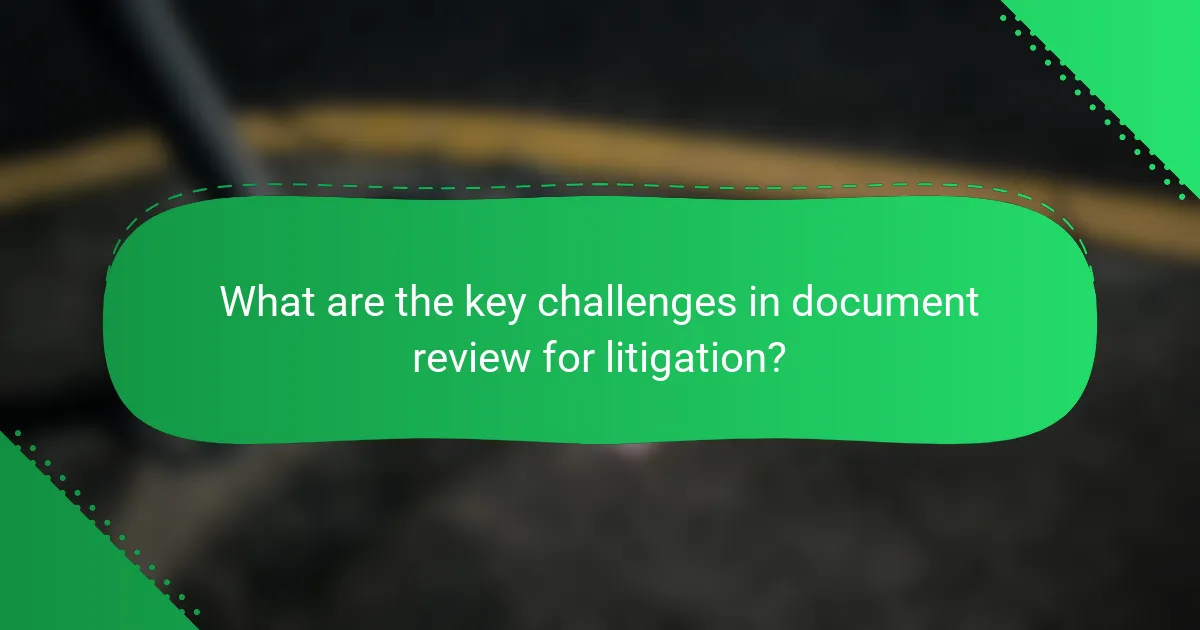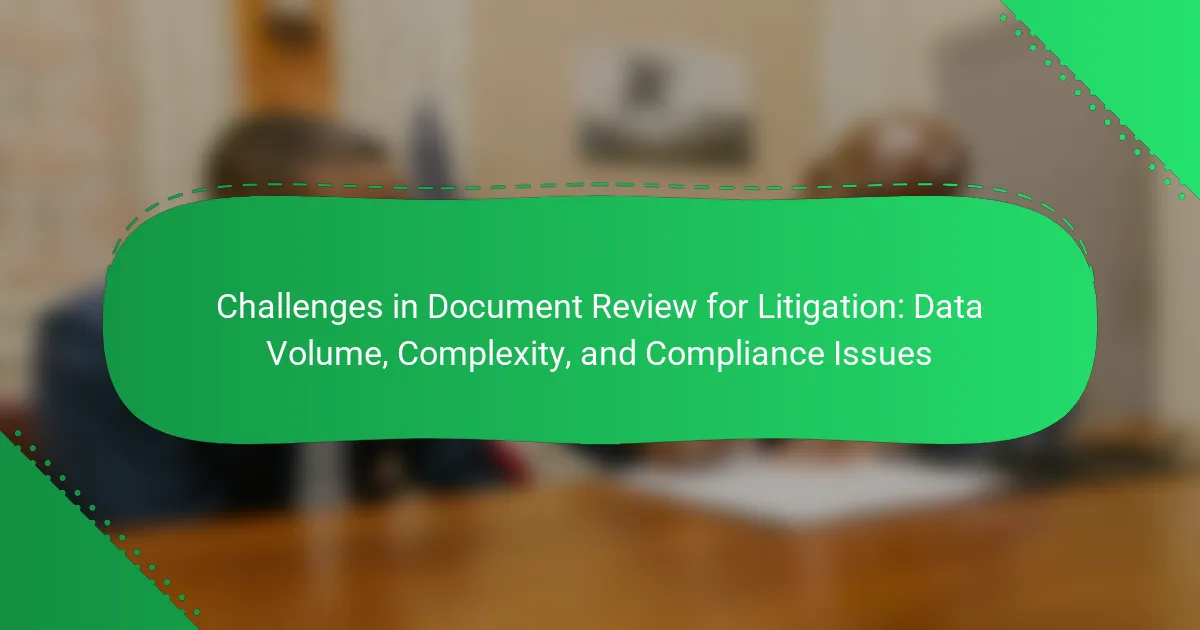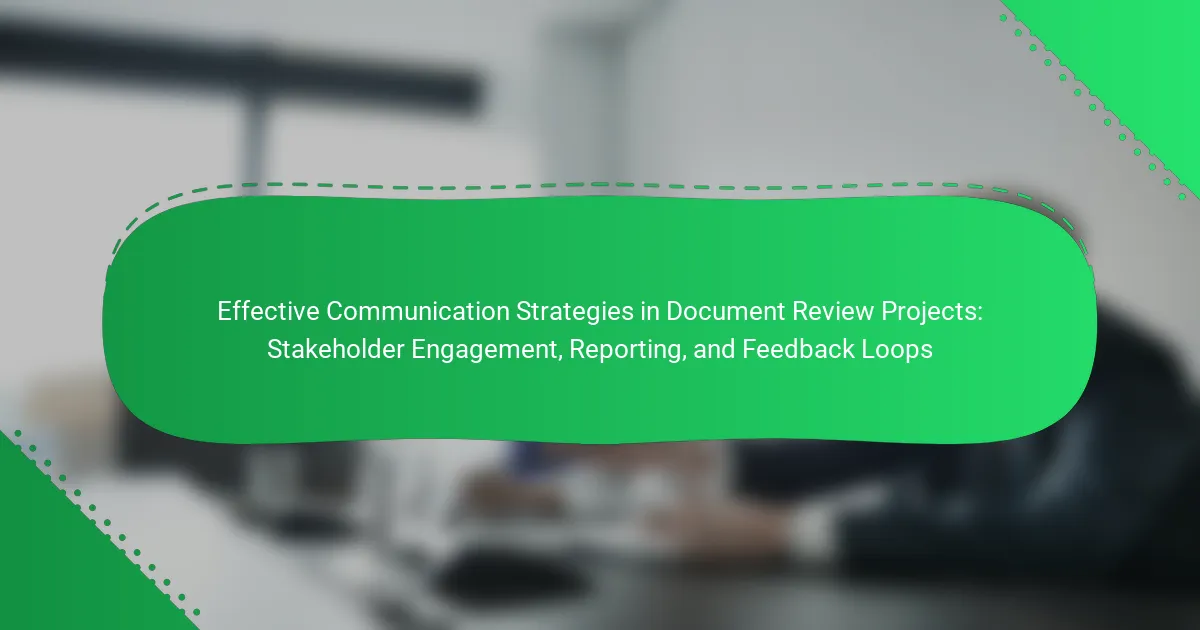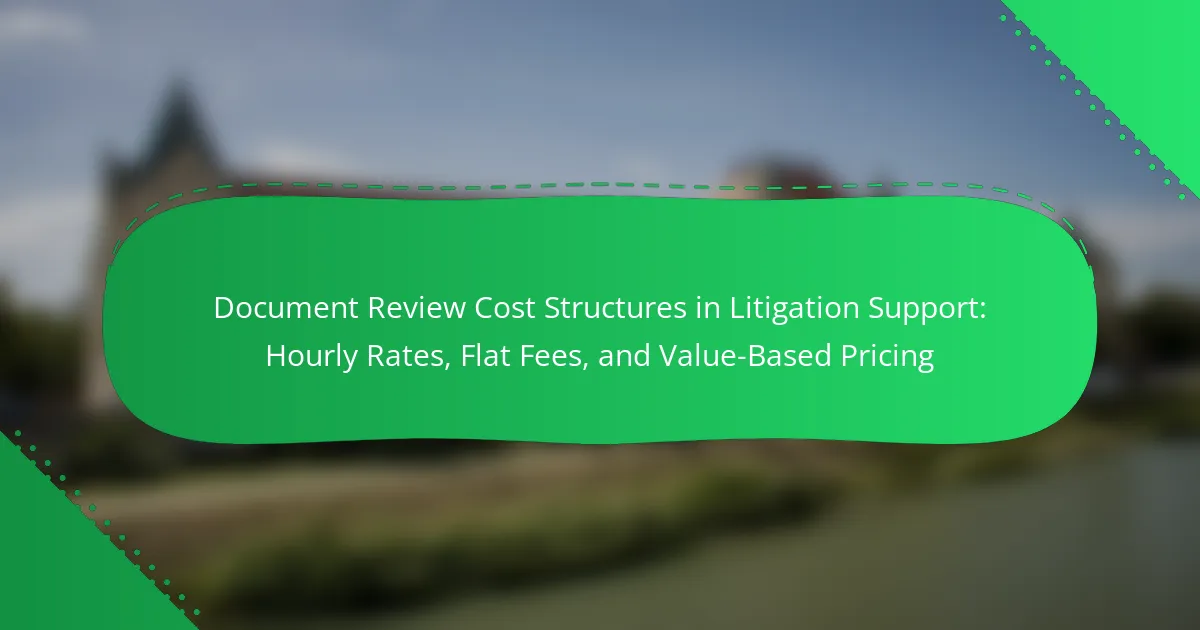Document review for litigation presents key challenges, primarily due to data volume, complexity, and compliance issues. Legal teams often face the daunting task of reviewing vast quantities of documents, which can lead to increased time and costs. The complexity of the review process is heightened by the need to navigate various legal standards and relevance criteria across different jurisdictions. Additionally, compliance with data privacy laws is critical, as mishandling sensitive information can result in significant legal penalties. Addressing these challenges requires the implementation of effective strategies and technologies to streamline the document review process.

What are the key challenges in document review for litigation?
The key challenges in document review for litigation include data volume, complexity, and compliance issues. Document review often involves sifting through vast amounts of data. Legal teams may face hundreds of thousands or even millions of documents. This high volume can lead to increased time and costs. Complexity arises from the need to understand various legal standards and relevance criteria. Different jurisdictions may have different rules, complicating the review process. Additionally, compliance issues can arise from data privacy laws. Legal teams must ensure that sensitive information is handled correctly. Failure to comply can result in legal penalties or sanctions. These challenges require effective strategies and technologies to manage document review efficiently.
How does data volume impact the document review process?
Data volume significantly impacts the document review process by increasing the time and resources required for analysis. Larger volumes of data necessitate more extensive review efforts. This can lead to higher costs due to the need for additional personnel or technology. Increased data volume may also complicate the identification of relevant documents. The likelihood of missing critical information rises with more documents to sift through. According to a study by the RAND Corporation, larger data sets can increase review time by up to 70%. Therefore, effective data management strategies are essential to streamline the review process.
What factors contribute to the increasing data volume in litigation?
The increasing data volume in litigation is primarily driven by the proliferation of digital communications. The rise of emails, social media, and instant messaging has led to an exponential increase in the number of documents generated. Additionally, organizations are required to retain more records for compliance and regulatory purposes. This retention often results in the accumulation of vast amounts of data over time. Furthermore, the complexity of cases has increased, leading to more detailed discovery requests. The integration of various data sources, such as cloud storage and mobile devices, adds to the challenge. According to a report by the International Legal Technology Association, the average data volume per case has grown significantly, highlighting these trends.
How does high data volume affect review timelines and costs?
High data volume significantly extends review timelines and increases costs. More data requires more time for thorough analysis. Reviewers must sift through larger quantities of information. This often leads to the need for additional personnel or technology. Increased staffing and tools incur higher costs. Studies indicate that larger datasets can slow down processing speeds. For instance, a review of 100,000 documents may take weeks, while 1 million documents could take months. Consequently, the financial impact can escalate rapidly. Efficient management and technology integration can mitigate these challenges.
What complexities arise during the document review process?
The document review process faces several complexities. These include managing large volumes of data. The sheer amount of documents can overwhelm teams. Additionally, documents may vary in format and quality. This inconsistency complicates the review. Legal standards must also be adhered to. Compliance with regulations adds another layer of difficulty. Moreover, identifying relevant information is challenging. Reviewers must sift through irrelevant content to find pertinent details. Finally, collaboration among team members can lead to communication issues. These factors collectively hinder an efficient document review process.
How do varying document formats complicate reviews?
Varying document formats complicate reviews by introducing inconsistencies in accessibility and interpretability. Different formats, such as PDFs, Word documents, and spreadsheets, require distinct software for viewing and editing. This diversity can lead to compatibility issues, making it difficult for reviewers to access all documents seamlessly. Moreover, formatting discrepancies can obscure important information, affecting the accuracy of the review. For instance, metadata may be lost or misrepresented when converting between formats. Additionally, varying formats can increase the time needed for document preparation and organization. According to a study by the American Bar Association, 70% of legal professionals report difficulties stemming from inconsistent document formats during reviews. This complexity can hinder efficient communication among team members and prolong the review process.
What role does the diversity of content play in document complexity?
Diversity of content significantly increases document complexity. Varied content types introduce multiple formats, structures, and terminologies. This variation complicates the review process, requiring specialized knowledge. Different content types may include text, images, and multimedia. Each type demands unique handling and analysis techniques. Consequently, reviewers face challenges in consistency and accuracy. Additionally, diverse content can lead to increased data volume. This escalation in volume further complicates the review and compliance processes. Effective management of diverse content is essential for successful document review in litigation.
How do compliance issues influence document review for litigation?
Compliance issues significantly influence document review for litigation by imposing specific legal and regulatory requirements. These requirements dictate how documents must be collected, stored, and reviewed. Non-compliance can lead to sanctions or adverse judgments in court. Organizations must ensure that their document review processes align with laws such as GDPR or HIPAA. This often necessitates additional resources and time for thorough compliance checks. Compliance issues can also complicate the identification of relevant documents. Legal teams must navigate these complexities to avoid potential pitfalls. Therefore, effective management of compliance issues is crucial for successful litigation outcomes.
What regulations must be considered during document review?
Regulations that must be considered during document review include the Federal Rules of Civil Procedure (FRCP). The FRCP governs civil litigation in federal courts and outlines the procedures for discovery, including document production. Additionally, the Health Insurance Portability and Accountability Act (HIPAA) is crucial when handling documents containing protected health information. The General Data Protection Regulation (GDPR) applies to documents involving personal data of EU citizens. The Sarbanes-Oxley Act (SOX) mandates retention policies for financial records. Compliance with these regulations is essential to avoid legal penalties and ensure the integrity of the document review process.
How can non-compliance affect the outcomes of litigation?
Non-compliance can significantly impact the outcomes of litigation. It can lead to unfavorable judgments or sanctions against the non-compliant party. Courts may interpret non-compliance as an admission of guilt or liability. This can weaken the non-compliant party’s position in negotiations or settlements. Additionally, non-compliance can result in increased legal costs due to prolonged litigation. For example, failure to produce requested documents can lead to court orders for compliance, adding to expenses. Ultimately, non-compliance undermines the integrity of the legal process, affecting the overall fairness of the trial.
What strategies can be employed to mitigate challenges in document review?
Implementing a structured approach is essential to mitigate challenges in document review. Utilizing advanced technology, such as AI-powered tools, can streamline the review process. These tools can quickly sort and categorize large volumes of documents. This reduces the time needed for manual review. Training team members on best practices enhances efficiency. Regular communication among team members fosters collaboration. Establishing clear guidelines ensures consistency in document handling. Conducting periodic audits helps identify and address issues early. These strategies collectively improve the accuracy and speed of document review.
How can technology aid in managing data volume during reviews?
Technology aids in managing data volume during reviews by automating data processing and analysis. Automation tools can quickly sift through large datasets. They can identify relevant documents based on pre-set criteria. This reduces the time spent on manual reviews. Artificial intelligence enhances the accuracy of document classification. AI algorithms can learn from previous reviews to improve future performance. Additionally, cloud storage solutions provide scalable options for data management. These solutions allow for easy access and collaboration among review teams. According to a report by the International Legal Technology Association, technology can reduce review costs by up to 30%.
What best practices should be followed to ensure compliance in document reviews?
Best practices for ensuring compliance in document reviews include establishing clear guidelines, maintaining thorough documentation, and implementing regular training. Clear guidelines help define review processes and expectations. Thorough documentation tracks decisions and actions taken during the review. Regular training keeps team members informed about compliance requirements and updates. Utilizing checklists can enhance consistency in reviews. Additionally, employing technology tools can streamline the review process and ensure adherence to compliance standards. Regular audits of the review process help identify areas for improvement and ensure ongoing compliance. These practices collectively support effective compliance in document reviews.
What are the implications of ignoring challenges in document review?
Ignoring challenges in document review can lead to significant legal and financial repercussions. Failing to address data volume issues may result in missing critical evidence. This oversight can weaken a case and lead to unfavorable outcomes in litigation. Complexity in documents can cause misinterpretation or misclassification of information. Such mistakes can hinder compliance with legal standards and deadlines. Non-compliance can result in sanctions or penalties from courts. Additionally, overlooking these challenges may increase the overall cost of litigation due to extended review times and potential rework. Ultimately, ignoring these challenges compromises the integrity of the legal process.
How can overlooking data volume issues lead to legal risks?
Overlooking data volume issues can lead to significant legal risks. Large volumes of data can result in incomplete discovery processes. Incomplete data can cause non-compliance with legal obligations. Non-compliance may lead to penalties or sanctions imposed by courts. Additionally, failing to manage data volume can obscure relevant information. This obscurity can hinder a fair trial. Courts may view negligence in data handling unfavorably. Such views can impact the outcome of litigation.
What are the potential consequences of failing to address document complexity?
Failing to address document complexity can lead to significant legal and operational risks. Increased errors in document review occur when complexity is overlooked. These errors can result in missing critical information, which can compromise case outcomes. Inefficient review processes often arise from complex documents, causing delays in litigation timelines. Resource allocation may become strained as teams struggle to manage intricate documents. Non-compliance with regulations can occur due to misunderstandings of complex legal language. This can lead to penalties or sanctions against involved parties. Ultimately, failing to address document complexity can jeopardize the integrity of the legal process.
What practical tips can improve the document review process for litigation?
Implementing a structured approach can significantly improve the document review process for litigation. Start by utilizing advanced document management software. This software can categorize and index documents efficiently. Establish clear guidelines for document relevance and privilege. This ensures consistency in the review process. Employ a collaborative platform for real-time communication among team members. This enhances coordination and reduces redundancy. Conduct regular training sessions for the review team. This keeps everyone updated on best practices and tools. Utilize technology-assisted review methods, such as predictive coding. This can expedite the review process while maintaining accuracy. Finally, prioritize documents based on relevance and complexity. This helps in managing large volumes effectively.
The main entity of this article is the challenges associated with document review for litigation, specifically focusing on data volume, complexity, and compliance issues. Key challenges include managing vast amounts of data, navigating various legal standards, and ensuring adherence to compliance regulations. The article delves into how data volume affects review timelines and costs, the complexities arising from diverse document formats, and the implications of non-compliance. Strategies for mitigating these challenges, including the use of technology and best practices for compliance, are also discussed to enhance the efficiency of the document review process.



